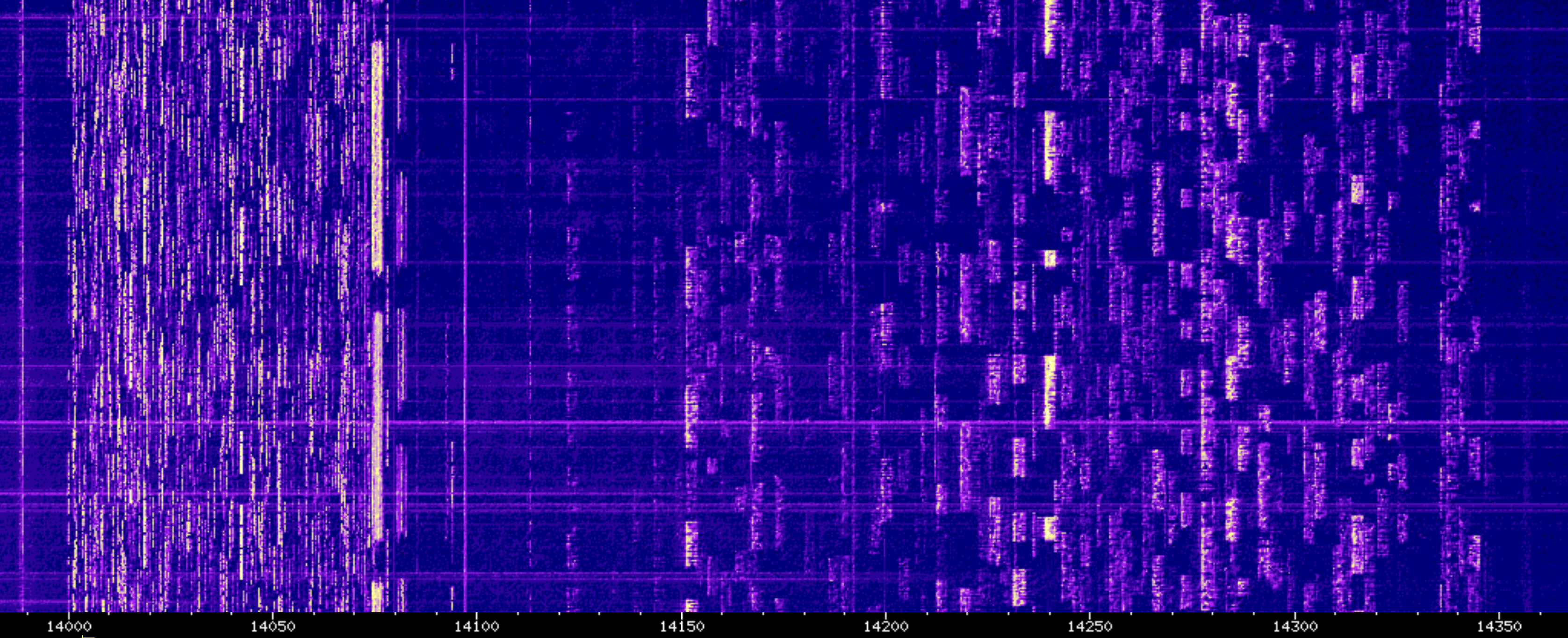this post was submitted on 14 Jul 2024
41 points (97.7% liked)
Amateur Radio
1003 readers
13 users here now
General amateur radio (ham radio) chat, questions, and news
founded 1 year ago
MODERATORS
you are viewing a single comment's thread
view the rest of the comments
view the rest of the comments

This is a wonderful question! This is a spectral waterfall display of audio frequencies. The dense area on the left are the CW (Morse code) portions of the spectrum where there are quite a lot of people communicating in Morse code. The bright bands just to its right is the FT8 data mode (which also uses audio frequencies) to send and receive very short messages. The broad area on the right are people communicating via voice transmissions on Single Sideband.
That is a lot of Morse code happening in this day and age!
I can't help but wonder what is being transmitted, the airwaves have held a constant sense of mystery and wonder ever since I was a boy, growing up in a town with no FM stations and nested between hills that blocked all FM signals from the big cities of Southern California.
But at night, when the entire region was covered in the low clouds of the marine layer, there were nooks and corners of the town where the radio signals came in loud and clear. Chasing those FM signals became a sort of hobby for some of us in town, we took along a portable radio/cassette player and recorded tapes of live late-night music from Los Angeles or San Diego.
Every once in a long while we picked up signals from stations too distant and weak (at the source) to normally make it as far as my town, but which somehow became amplified in foggy conditions, some far-out-there music from college or pirate radio stations.
The thrill of stumbling upon something like this while scanning the lower extreme of the dial, then suddenly getting a blast of Killing Joke (post-punk) or Koch (lo-fi reggae), was like finding myself in Herman Hesse's "Steppenwolf" theater: "For Madmen Only - Price Of Admission - Your Mind".
Through the following years and few decades, I explored AM and shortwave, and I can't even begin to describe the sensation I felt while scanning the dial very late one night and being confronted by a Numbers Station, that nearly robotic female voice reciting: "eight, nine, five, seven, seven... nine, three, eight, one, seven... four, seven, six, one, seven..."
It was only after all this that the internet came into being, and the very first thing I did with it was search for live radio, the very first app I downloaded was Real Player ("buffering"... lol).
But the romance of electromagnetic waves persists in me, I only listen to stations that also transmit over the airwaves somewhere in the world, there's a feel to them that online-only stations cannot seem to be able to replicate.
You can listen to your heart's content here: http://websdr2.sdrutah.org:8902/index1a.html?tune=14290usb (where this image is from).
If you want to get in on the action, consider pursuing your Amateur Radio Operator's License. If you're in the US, the Amateur Radio Relay League is a sufficient place to start, and you can use hamstudy.org to prepare for your test.
In the 14Mhz range you'll see a diurnal oscillation of who you can hear because during the day this particular band tends to only get out to about 1500 miles, at night we can reach over 10,000 miles. I've had plenty of contacts with Japan, and on digital modes I've gotten out to 11,000 miles. I've made contacts in Indonesia from New Mexico. On digital mode (which does not use voice) I hit the Reunion Islands on the east side of Africa with only 100W and a vertical omnidirectional antenna.
Number stations are wild. There's even more to signals intelligence, too. There are Over the horizion radars (OTHR) and bouys, wave radars, and wildly encrypted digital bursts–all of which you can hear.
I was curious about why so much morse myself (forgive my love of a little alliteration). Found this on the site for the competition:
Morse code (a.k.a. continuous wave/CW) is really great for low power operating (QRP) and a signal can break through a lot more than voice (SSB) can. CW only radios can also be tiny and are valued by hams who enjoy portable operating and there are programs/events that promote just that. It can also be a lower cost way to get into a potentially expensive hobby. Also, it's just fun to copy the code sometimes.